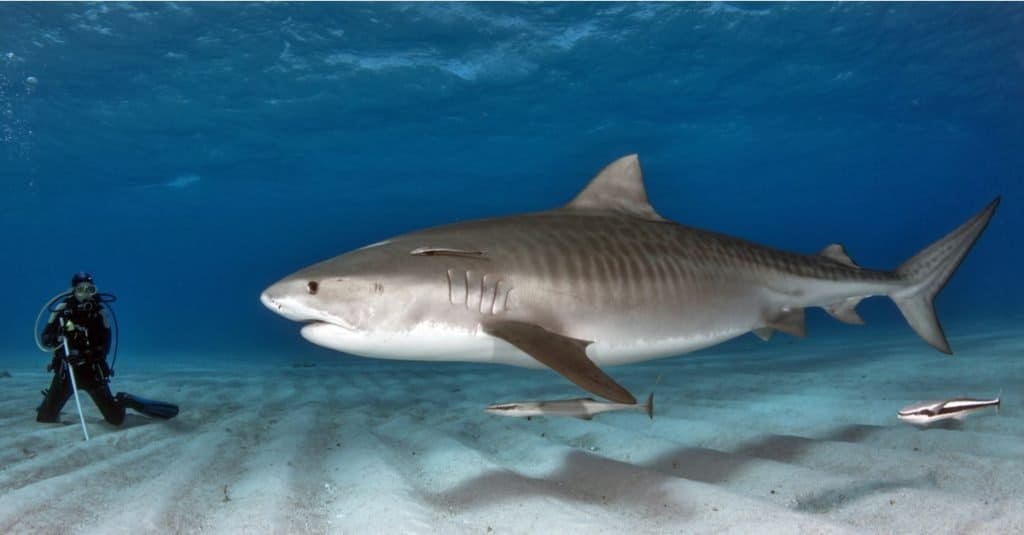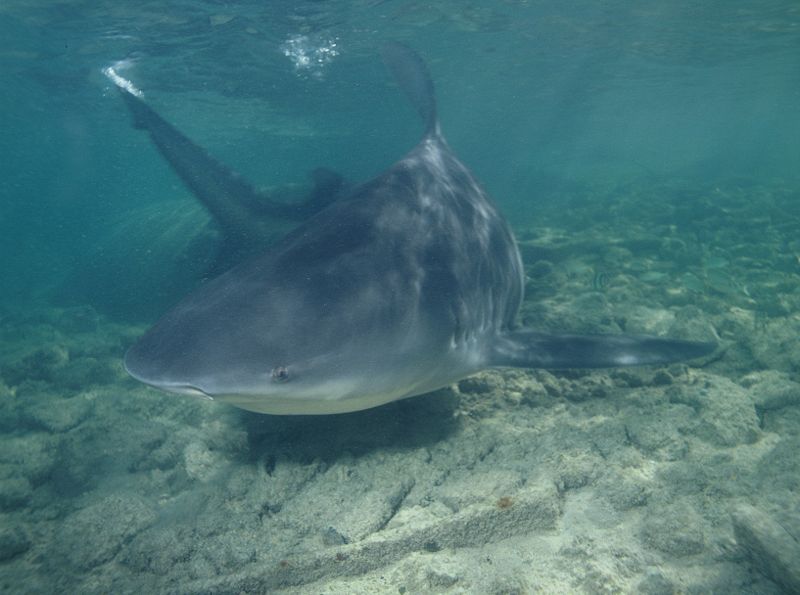Key Points:
- The five largest shark species present in Alabama waters are: great white sharks, tiger sharks, scalloped hammerhead sharks, sand tiger sharks, and bull sharks.
- The biggest bull shark ever caught off Alabama weighed 448 pounds and measured 8 feet 10 inches long. It was caught in 2015 by a Birmingham fisherman near Gulf Shore.
- The largest tiger shark ever caught off Alabama weighed 595 pounds and measured more than 8 feet long, killed in 2022 as part of the Alabama Deep Sea Fishing Rodeo in the Gulf of Mexico.
The extreme southwestern tip of Alabama lies on the Gulf of Mexico, which is home to numerous sharks. Alabama is home to several large species of shark, though encounters with humans are rare. Currently, many sharks swimming in Alabama’s coastal waters are listed as endangered and face extinction. Attacks on humans at Alabama beaches are rare, as are instances of fishers landing large sharks.
That’s why, when someone hauls in a giant shark off the coast of Alabama, people take notice. Here, we’ll learn about the five largest sharks swimming in Alabama’s waters. Then, we’ll look at the biggest shark ever caught off Alabama. We’ll learn just what kind of sharks beachgoers might encounter and why sharks are so important to the marine ecosystem and our planet as a whole.
The Largest Sharks in Alabama Waters
Sharks have been living in Alabama waters for a very, very long time. So, it’s no surprise that some of the largest sharks in the world sometimes visit coastal Alabama. Let’s take a look at the five biggest sharks swimming in Alabama waters.
1. Great White Shark

, the great white shark, is vulnerable to extinction globally.
©Ramon Carretero/Shutterstock.com
Great white sharks are some of the most famous sharks in the world. They can reach lengths of over 20 feet and weigh more than 2,000 pounds. Mature adults tend to stick to deep ocean waters, while juveniles (less than nine feet long) stay in safer, shallower water. Great whites are named for the white color of their bellies; their sides and backs are gray. They have torpedo-shaped, conical bodies and eat seals, sea lions, sea turtles, fish, and dolphins.
2. Tiger Shark

, the
tiger
shark, is one of nature’s most awesome and beautiful predators.
©Tomas Kotouc/Shutterstock.com
One of the largest sharks found in Alabama waters, the tiger shark grows up to 14 feet long. These sharks have irregular stripes on their sides, with small dorsal fins and pale bellies. Tiger sharks have blunt, squarish noses and tipped serrated teeth. They’re known for eating fish of all kinds, as well as any kind of garbage, carrion, or detritus they encounter.
3. Scalloped Hammerhead Shark

, the scalloped
hammerhead shark
, is one of the most endangered sharks on the planet.
©Ian Scott/Shutterstock.com
One of the largest sharks in Alabama waters, the scalloped hammerhead is now found in only small numbers. Their population has fallen drastically due to overfishing. These sharks grow up to 14 feet long and live primarily in shallow coastal waters. They get their name from the curved, scallop-like front of their hammer.
4. Sand Tiger Shark

, the sand tiger shark, is critically endangered and in danger of going extinct.
©iStock.com/mirror-images
Sand tiger sharks are some of the most common sharks in the Gulf of Mexico. They grow up to 11 feet long, but despite their size and fearsome looks, they rarely attack humans. These sharks spend their days slowly swimming along sand bars and coral reefs. They’re critically endangered and eat fish, squid, octopus, and other cephalopods.
5. Bull Shark

, the bull shark, is vulnerable to extinction but has fared better than other shark species.
©Carlos Grillo/Shutterstock.com
A common target of sport fishermen because of their fight and aggression when hooked, bull sharks grow up to 11 feet long. They have torpedo-shaped bodies with long tails designed for hunting fish. Bull sharks are the only sharks in Alabama capable of swimming inland through freshwater rivers. These sharks, along with tiger sharks and great whites, are responsible for the majority of attacks on humans.
The Biggest Sharks Ever Caught Off Alabama
The largest bull shark ever caught off Alabama weighed 448 pounds and measured 8 ft 10 inches long. It was killed in 2015 by a Birmingham fisherman near Gulf Shore. The fisherman was fishing for red snapper when the shark took hold of the bait over a coral reef.
The largest tiger shark ever caught off Alabama weighed 595 pounds and measured more than 8 feet long. This tiger shark was killed in 2022 as part of the Alabama Deep Sea Fishing Rodeo, which takes place annually in the Gulf of Mexico. In addition to the nearly 600-pound tiger shark, fishermen hauled in two more tiger sharks weighing 466 and 438 pounds, respectively.
Are There Sharks in Alabama Beaches?

Luckily, shark attacks in Alabama are extremely rare.
©Albert Kok at Dutch Wikipedia (Original text: albert kok), Public domain, via Wikimedia Commons – License
A small portion of Alabama lies on the Gulf of Mexico. Beaches here are popular destinations for tourists, swimmers, and fishermen. As a part of the greater Gulf of Mexico ecosystem, beachgoers and fishers alike may encounter any number of sharks. Some of the most common sharks near Alabama beaches include bull sharks, spinner sharks, blacktip sharks, and Atlantic sharpnose sharks.
All swimmers, surfers, waders, kayakers, and paddleboarders enjoying Alabama’s coastal waters should remember the key steps to staying safe around sharks. First, always swim with a buddy. Avoid wearing contrasting colors or reflective jewelry, as these attract sharks’ attention. Don’t splash unnecessarily, and don’t swim in areas that are commonly fished.
Are Sharks Endangered?
Worldwide, shark populations have declined by more than 90% in recent decades. As keystone species, sharks are vital to the health of the entire marine ecosystem. Their presence, or absence, at the top of the food chain impacts the entire food web. In other words, the health of our oceans relies on sharks, and sharks need our help.
Conserving sharks starts with educating yourself on sharks and why they’re important. The biggest threats to shark populations today are overfishing, the shark fin soup industry, pollution, and ocean acidification. To help sharks and all marine species, you can reduce plastic use (especially single-use plastic) and choose sustainable seafood options. Finally, learn more about overfishing, the shark fin soup industry, and how it impacts shark populations globally.
The photo featured at the top of this post is © Willyam Bradberry/Shutterstock.com
Thank you for reading! Have some feedback for us? Contact the AZ Animals editorial team.






